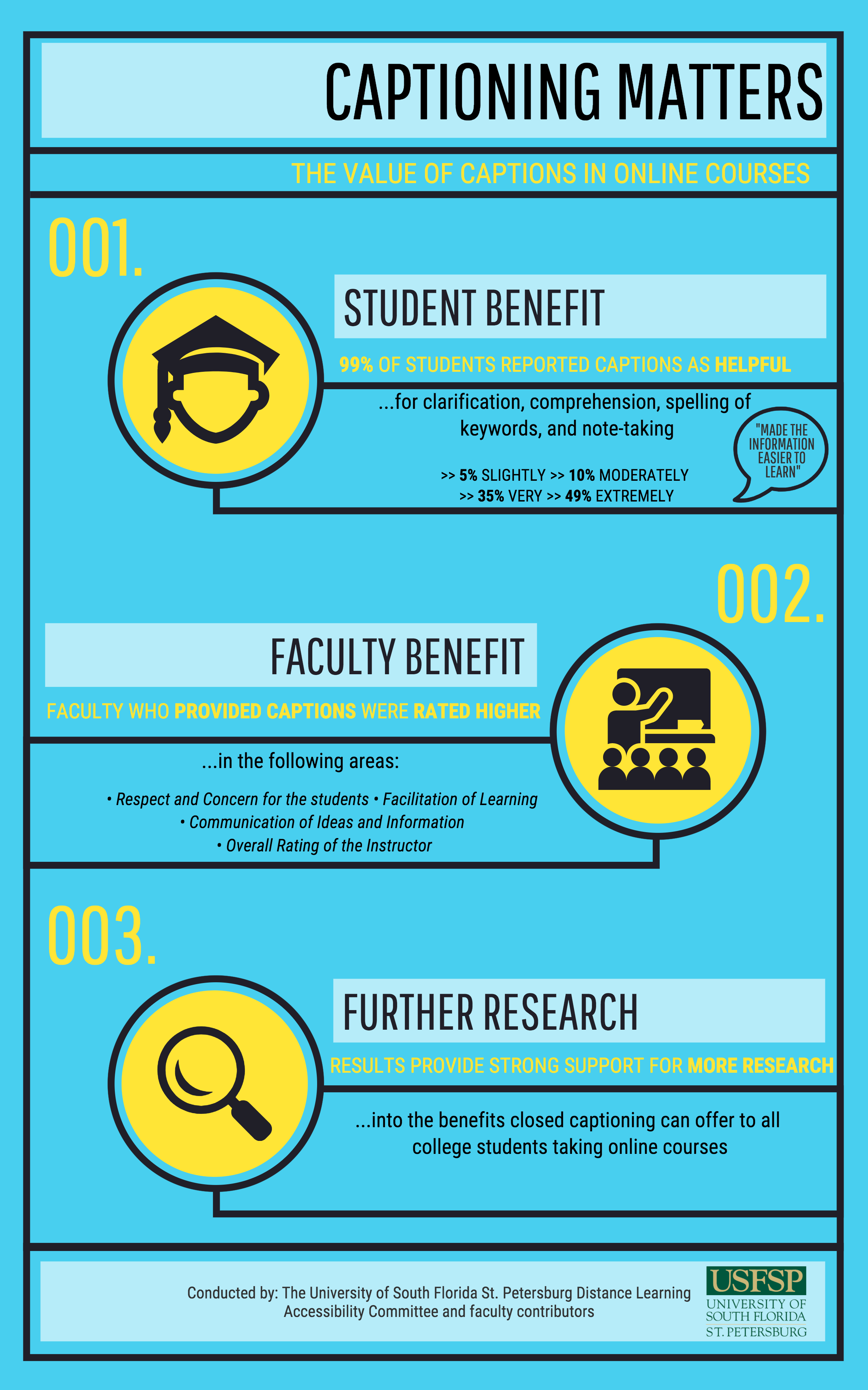Study Shows Adding Captions Improves Faculty Evaluations + Helps Students Learn [INFOGRAPHIC]
Updated: February 10, 2021
In today’s bustling and tech-y world it’s no surprise that the number of online courses is growing. An increase in online video in higher education has caused institutions to pay closer attention to closed captioning in terms of legal requirements, accessibility, and its impact on students in the classroom – whether that be a physical or virtual space.
The University of South Florida St. Petersburg (USFSP) Distance Learning Accessibility Committee along with faculty contributors conducted a small-scale study to better understand the benefits of providing captioning for students in an online course. This investigation – although not conclusive – has yielded results strongly supporting the idea that captioning is beneficial to all students regardless of disability, as well as beneficial to faculty.
Closed captioning, while a basic technology, is an extremely important one. The results of this initial study indicate that further research should be conducted on this topic to better understand the correlation between captions and the observed student and faculty benefits.
Captioning Benefits for Students
It has been hypothesized that closed captioning is beneficial to students taking online courses. With 99% of students reporting that they found closed captions to be helpful, it is clear that this study supported that hypothesis. 5% of students responded that captions were slightly helpful, 10% moderately helpful, 35% very, and 49% extremely. It was also determined that there were four areas in particular in which captions were beneficial – clarification, comprehension, spelling of keywords, and note-taking.
The results of this study are very similar to the findings from the National Research Study: Student Uses and Perceptions of Captions & Transcripts. Conducted by Oregon State University’s (OSU) Ecampus Research Unit, the national study found that 98.6% of students reported finding captions helpful. Looking at their qualitative responses, the results were quite similar to the USFSP study regarding the specific areas in which captions are an assistive learning tool with the four sub-themes being accuracy, comprehension, retention, and engagement.
Clarification
Several students reported intermittent difficulty hearing the instructor. Whether it be from background noise or poor audio, the captions helped these students to fully understand the lecture even at times they had difficulty hearing. One person noted, “Close caption helped me because I was able to read and process what was being said a little easier” while another explained, “The closed caption helped when viewing [sic] the videos at home, because I have small children and at times they can be loud.” Similar to clarification, accuracy was a common theme found in the OSU study. In fact, 62.61% of students from the national study reported using captions because of poor audio, 42.48% when in sound-sensitive environments, and another 18.63% use captions for hearing difficulty.
Comprehension
Individuals reported that it was helpful to hear and see the content, especially for those who described themselves as “visual learners.” One remark from a student was “They clarified any misunderstandings or miscommunications. Made the information easier to learn because I am more of a visual learner.” 52% of students from the OSU national study also reported using captions to improve comprehension, noting that captions helped with “visually seeing key points, connecting ideas between text and visual representations, offering information in more than one way, learning English as a second language, following the video content, playback or pausing for review, learning a foreign language, and organizing information.”
Spelling of keywords
In addition to helping understand and comprehend the material more easily, captions also help with learning unfamiliar or exceptionally challenging words. One student noted, “…there were many legal terms that I did not know of and the captions helped me learn how to spell them.”
In the national study as well, students reported that captions helped them with unfamiliar terminology, allowed them to distinguish between similar sounding words, and demonstrated the correct spelling of names and terms. When asked why they use closed captions, 27.3% of students in this study reported using captions for help with difficult vocabulary.
Note-taking
Perhaps unsurprisingly, students felt that captions were helpful for note-taking. Research suggests that taking notes while watching video-based lectures helps students to remember more and demonstrate better understanding. More specifically, a student explained “When I was taking notes I was able to pause the video and use the captions rather than rewind and repeat the video.” Similarly, a comment from the national study read, “If I need to write down notes, I know exactly how to quote a video.”
Captioning Benefits for Faculty
While the benefit of captions for students may not come as a complete surprise, it was found that captions can benefit faculty as well. Many faculty members are happy to be able to provide this option for their students both as an accommodation and as a learning tool. Additionally, faculty who offered captioning on their material were rated more highly, particularly in four different areas:
- Respect and Concern for the Students
- Facilitation of Learning
- Communication of Ideas and Information
- Overall Rating of the Instructor
Although not observed in this particular study, it seems likely that if providing captions can improve faculty rating, it may have similar impacts on the institutions which provide captioning.
Download our infographic: Captioning Matters: The Value of captions in Online Courses

Further Reading

Subscribe to the Blog Digest
Sign up to receive our blog digest and other information on this topic. You can unsubscribe anytime.
By subscribing you agree to our privacy policy.






